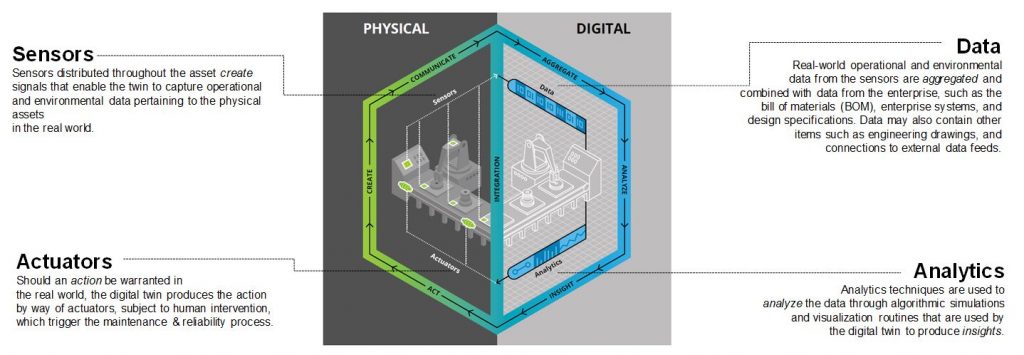Using IoT to create a digital twin: Two is smarter than one
The world is full of tough questions, especially within the IoT industry. How do you know when a jet engine is about to fail? How do you efficiently build a customized car? How do you know how a vehicle will perform in the real world? Traditionally, there were no answers to these questions more accurate than a guess. Today, IoT can be used to model the physical world and provide answers to even the toughest operational questions. And when you add digital twins into the mix, IoT becomes even more powerful.
IoT and insight into the real world
The power of IoT is its ability to link the physical and digital worlds. All of the technology behind IoT — the sensors, connectivity, analytics and platforms — work together to turn details from the physical world into digital information. In the digital world, that information can be seen and analyzed with other data to draw out new insights that can be applied back in the physical world to improve performance.
But this can raise the question, what should we do with that IoT-derived information in the digital world? What is the best way to analyze it to answer the most pressing business questions? One answer is the digital twin.
What is a digital twin?
The digital twin is an exact copy of a physical object or process. More precisely, it is “an evolving digital profile of the historical and current behavior of a physical object or process that helps optimize business performance.” In other words, sensors from IoT ingest digital data about physical performance in the real world to inform the digital twin. Analytics comb through this data to identify deviations from optimal performance levels or even test potential future scenarios. Actuators — anything from switches to 3D printers — can act based on the analytics’ findings to improve real-world performance.
In this way, the digital twin offers an opportunity for IoT to do more. It can model the performance of a variety of physical objects. For example, a digital twin of an individual vehicle can model when its transmission will fail based on how it specifically has been driven. But the digital twin can also model processes that stretch across multiple physical objects. For example, with sensors on all of the machinery on a production line, plant managers can create a digital twin of the production process. Managers could use this to see how raw materials are flowing through the line, where there are bottlenecks and how to best handle a sudden increase in demand. Bringing together IoT and digital twins has the potential to offer companies revolutionary changes.
The positive results
Because a digital twin can model either a product or a process, organizations can use them to improve operations in a variety of ways.
IoT and digital twins for a product: One luxury automaker had a challenge: how to produce a highly customizable car that could have more than 70,000 different configurations? The answer was to use IoT and digital twins in the design and production of the car. Digital designs allowed the right parts to be in the right place to assemble each individual car. Sensor readings on each car could then be compared to designs to ensure that everything was correct and quality standards were met. In this way, even with so much variation, the time to market was a mere 16 months compared to the two to three-year industry average, while production throughput increased more than three times over previous benchmarks.
IoT and digital twins for a process: A leading electronics company faced a different problem in its production of air conditioners, specifically how it could most efficiently produce them. The company used IoT and 3D scanners to create a fully automated production system with integrated machine controls. The benefits of this automation included lower lead times for customers and lower overall costs, along with a 25% improvement in production capacity with 50% fewer defects.
IoT and digital twins for both: If those are the results possible from using IoT and digital twins on a product or a process, what can be possible when using both? Top-level Formula 1 race teams do just that. They use detailed digital twins of their cars to do predictive maintenance, but they can also then combine those digital twins with twins of race tracks. This allows drivers to virtually drive each track and teams to fine-tune processes and race strategies long before they ever arrive on site.
Getting started
The idea of using sensors and IoT to create an entire virtual model of your product or production line can seem daunting, but it need not be so. Many successful organizations approach digital twins with a “think big, start small, scale fast” approach. That is to say, find the areas where IoT and digital twins can contribute today and use those to demonstrate success before scaling to more and more areas.
In fact, our research suggests that a simple change in mindset can help organizations adopt transformational strategies even while using legacy systems. Rather than focusing on capital investments to improve entire systems, organizations should take a data-centric approach, looking at what data is already available and what insights they can glean from it.
In that way, companies can quickly take advantage of the powerful combination of IoT and digital twins, and they can see for themselves that “two is better than one!”
All IoT Agenda network contributors are responsible for the content and accuracy of their posts. Opinions are of the writers and do not necessarily convey the thoughts of IoT Agenda.

